2019 Energy Code Changes are Coming
The new 2019 code coming into effect on January 1 is a lot tougher than the current code.
The new 2019 code coming into effect on January 1 is a lot tougher than the current code.
SELMA, Calif. (KFSN) — The end zone may finally be in sight for the completion of Selma High School’s much-anticipated football stadium.
The district had originally hoped for an August finish, but construction was delayed.
“It was an aggressive, optimistic timeline to begin with,” explained Assistant Superintendent Larry Teixeira of the Selma Unified School District. “We have folks that are disappointed we missed our home football season.”
The Superintendent’s office says they weren’t surprised the stadium was still under construction when that anticipated august 15th completion date rolled around.
“We did run into some issues during construction,” Teixeira explained.
Construction started back in February, but between the wet winter, delays at the building manufacturer, and problems securing the field light footings into the ground the District is now on track for a November 15th finish.
“We’re bringing Selma into the 21st century and preparing for beyond,” said Superintendent Tanya Fisher.
If it’s ready a little sooner? All the better.
“We’re all keeping our fingers and arms crossed that we can make that first Kingsburg game because they’re our big rivals and we want to beat Kingsburg for the first game in our new stadium,” Teixeira continued.
“We have 2nd and 3rd generations who were formerly Selma bears,” added Fisher. “Folks are really excited about having their children and grandchildren and future generations enjoy the stadium.”
The completed stadium will cost around $12 million dollars with that price tag picked up by voters who passed Measure O in November of 2016.
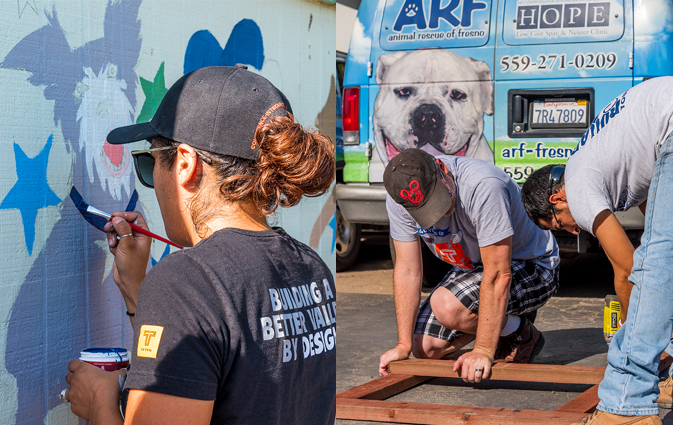
For the second year in a row, TETER donated design, labor, and materials to Animal Rescue of Fresno (ARF), a Fresno no-kill dog rescue shelter. Partners and staff volunteered their time and talent building three new shade structures, painting three new murals, and bathing dozens of rescue dogs.
Mindi Miller, Vice President of ARF expressed her gratitude to TETER:
“Thank you so much TETER for coming out to ARF. We’re so grateful to your team for designing and building shade structures for three of our small dog yards. You’ve provided the dogs much needed shade in the summer. Your shade structure gives the dogs a place to lay down and get off the dirt in the hot summer and mud in cold winter. The mural paintings on the Tuff Sheds brightens up ARF. We appreciate all your hard work. We actually caught the dogs barking at your mural paintings because they thought it was a real dog! Thank you very much for helping make ARF even safer for the resident animals until they find their forever home.”
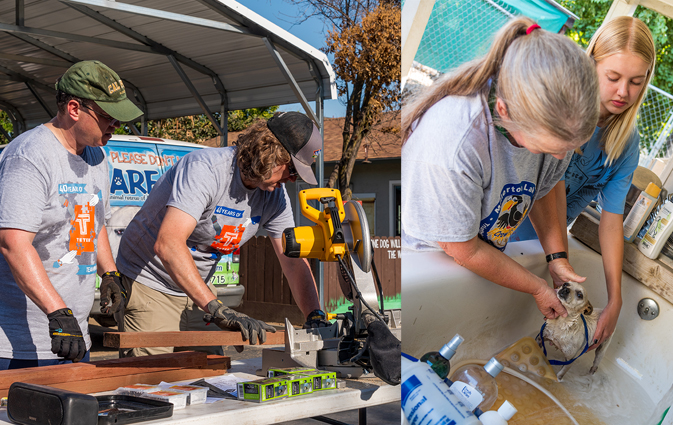
Eric Bailey (Structural Engineer) and Robert Thornton (Partner and Architect) cut wood to build shade shelters. Lynn Lyle (Construction Administrator) and a volunteer bathe a rescue dog.
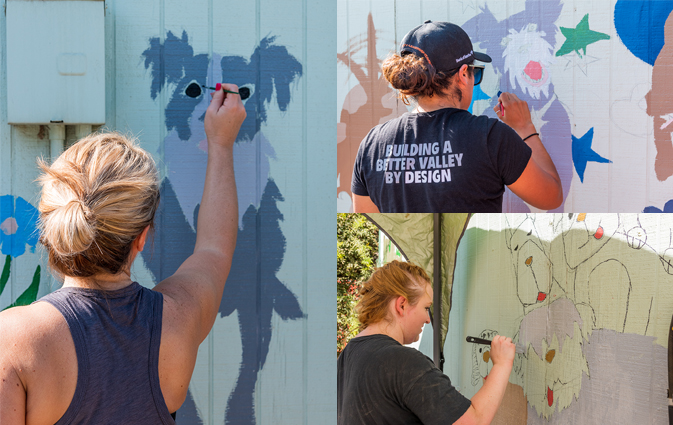
Jenn Smith (Project Administrator), Fritzi Martinez (Construction Design Professional), and Lisa Ruffoni (Project Administrator) brighten plain Tuff Sheds by painting colorful murals.
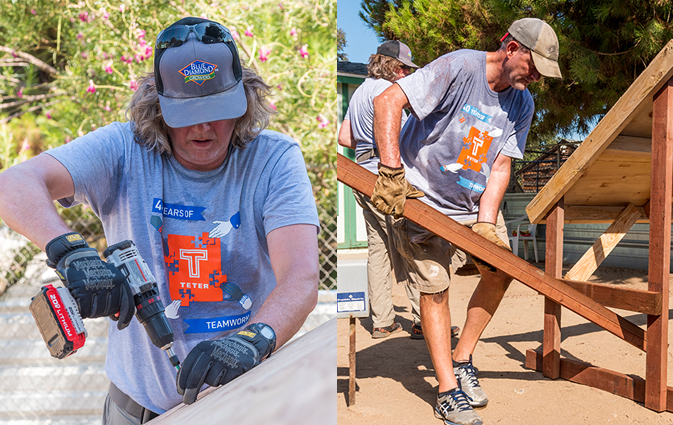
Robert Thornton and Jamie Hickman (TETER Partners and Architects) build new shade shelters for rescued dogs.
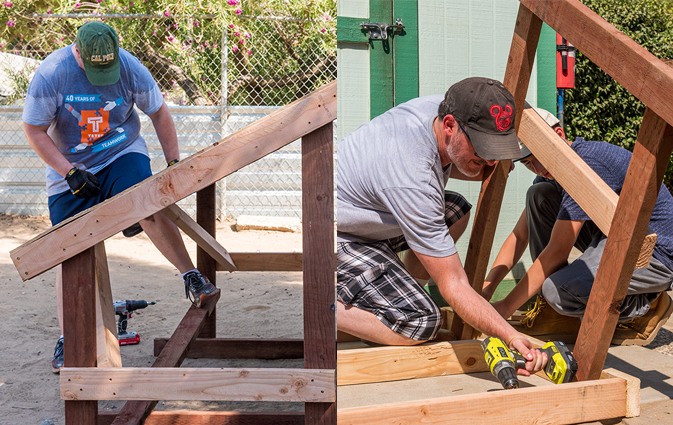
Eric Bailey (Structural Engineer) and Erin Garcia (Architect) build new shade shelters for rescued dogs.
In the South Valley, more than 30,000 students returned to school for Visalia Unified School District on Thursday. That includes hundreds of students at Ivanhoe Elementary. The school recently underwent a major modernization that included new flooring, new paneling, and even some new TVs.
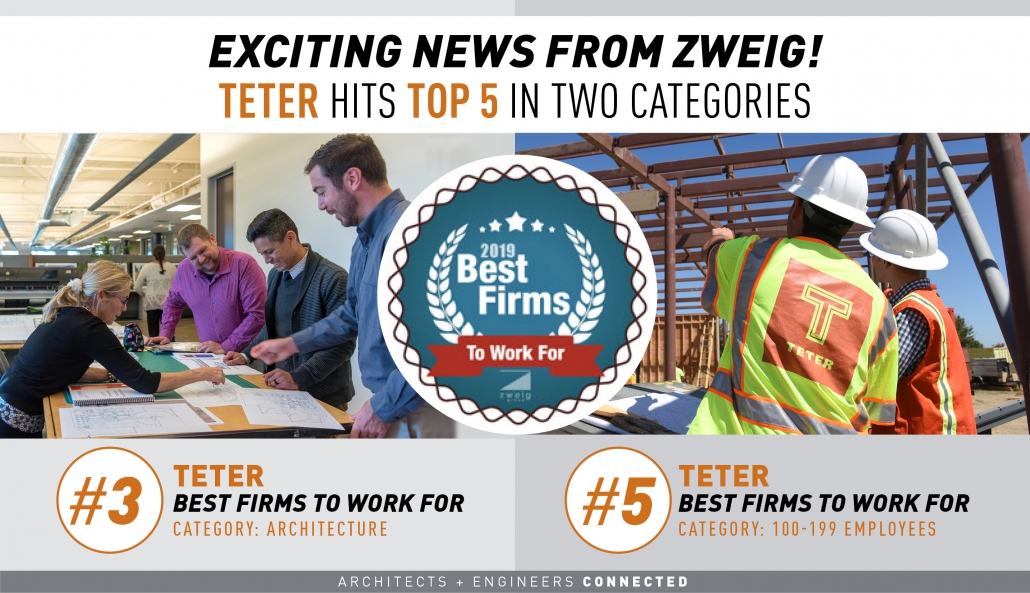
Zweig Group’s “The Best Firms to Work For” award recognizes the top architecture, structural engineering, civil engineering, environmental, geotechnical, landscape architecture/planning and multidiscipline firms in the US and Canada based on their workplace practices, employee benefits, employee retention rates, and much more.
TETER is ranked as the #3 “Best Architecture Firm to Work For” and ranked #5 “Best 100-199 Employees Firm to Work For”.
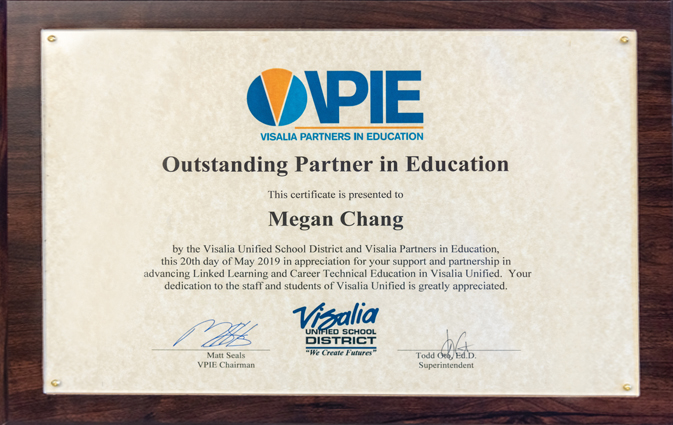
Visalia Unified School District and Visalia Partners in Education recognize Megan Chang (TETER Associate / Professional Engineer) for her dedication and support of their Linked Learning Academies and Career Technical Education programs:
“Megan Chang has been an active advisory board member for the Architecture and Engineering Academy at Redwood High School and currently serves as its chairperson. Her ongoing support for the academy goes beyond attending meetings as evident in her involvement and interactions with students both inside and outside of the classroom. This past February, Megan helped coordinate various activities for Engineering Week at Redwood which included guest presentations and lunch with professionals from TETER and an essay writing competition for young women interested in the field of Engineering. I wish more industry partners were committed to our students and made the high level of contributions like her, which allows our students opportunities to explore and expand their interest in a career field of choice. The Architecture and Engineering Academy would like to thank Megan for serving as an inspiration for many of our students, especially the three girls in our program who now have a role model to follow.“
Megan, who was unable to attend the event, expressed her appreciation:
“I am honored to receive this recognition. I’m also honored to work alongside the great Redwood High School faculty and other design professionals to help these bright Academy students achieve their dreams in Architecture and Engineering. Volunteering with the Academy for the past five years always brings a smile to my face. I love watching the kids smile, and get excited and amazed at what they can achieve with the knowledge they’ve learned. I’m looking forward to many more smiles in the years to come!”
TETER Partner, Robert Thornton, accepted the recognition on Megan’s behalf.
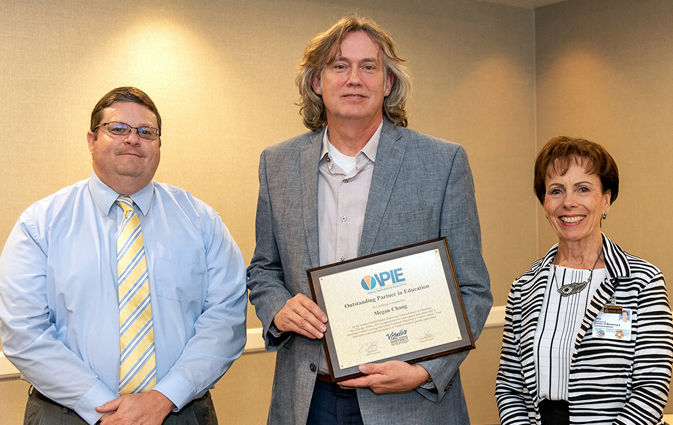
(Left to Right) Jamon Peariso Ed.D. (Director of College and Career Readiness), Robert Thornton (TETER Partner), and Dru Quesnoy (VPIE Board and Marketing Director Kaweah Delta Hospital)
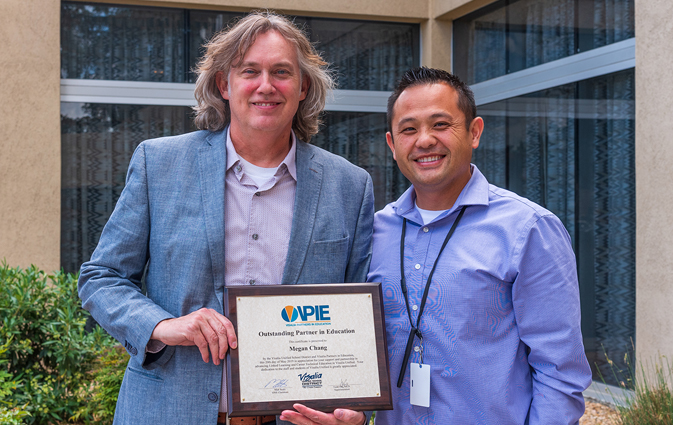
Robert Thornton (TETER Partner) and Tou Lor (Assistant Principal – Student Supervision)
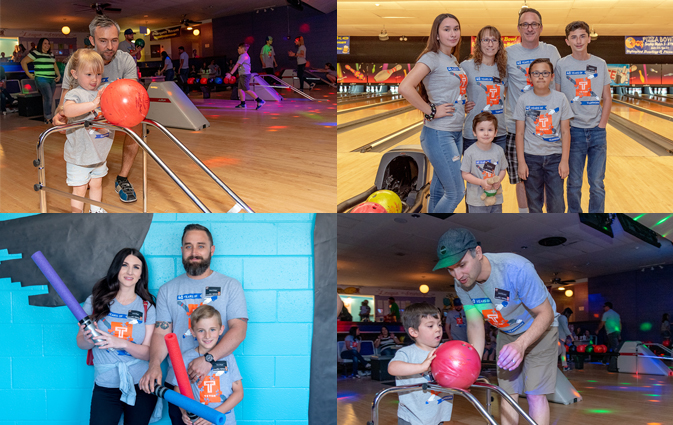
Staff from all five TETER offices (Fresno, Visalia, Modesto, Bakersfield, and San Luis Obispo) and their family enjoy bowling, billiards, arts and crafts, kids’ games, pizza, and winning raffle prizes.
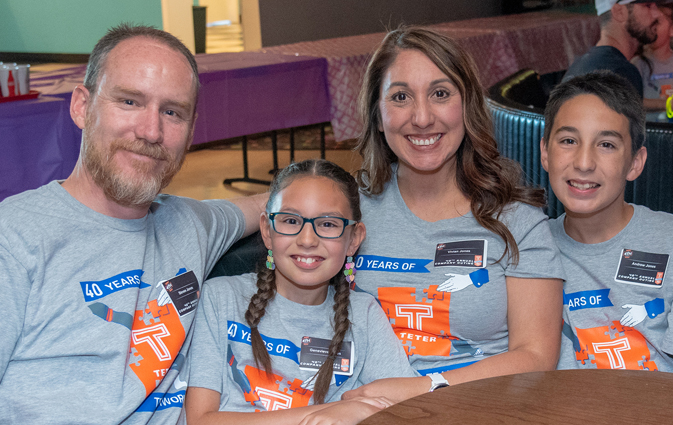
Mechanical Engineer Steven Jones (far left) and his family.
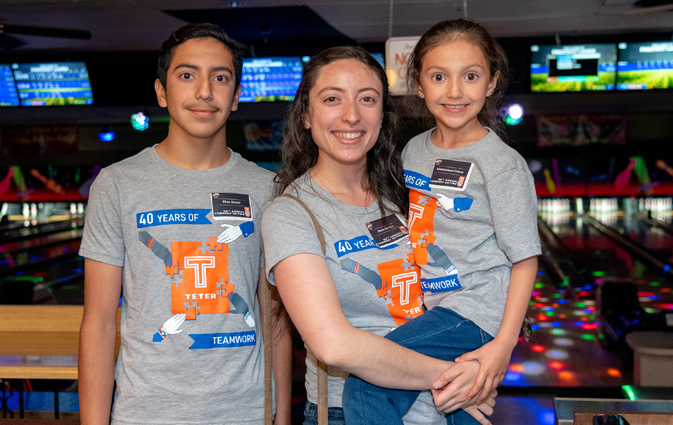
Design Professional Sonia Orozco (center) and her family.
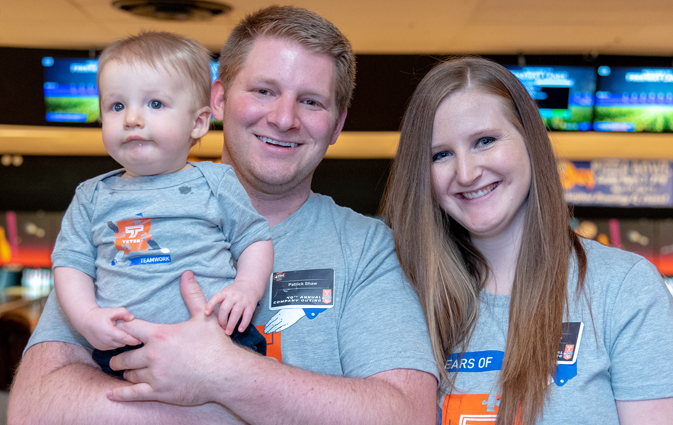
Electrical Engineer-In-Training Patrick Shaw and his family.
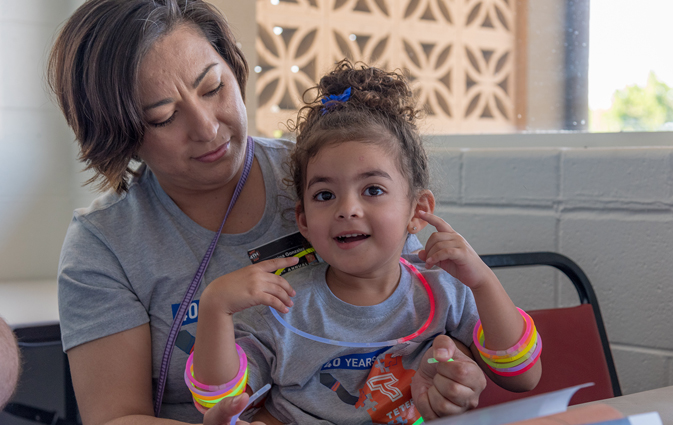
Design Professional Guillermina Gonzales and her daughter.
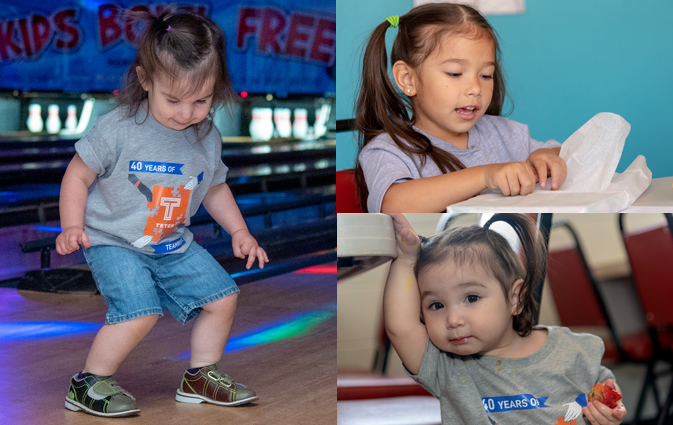
Future TETER Architects and Engineers.
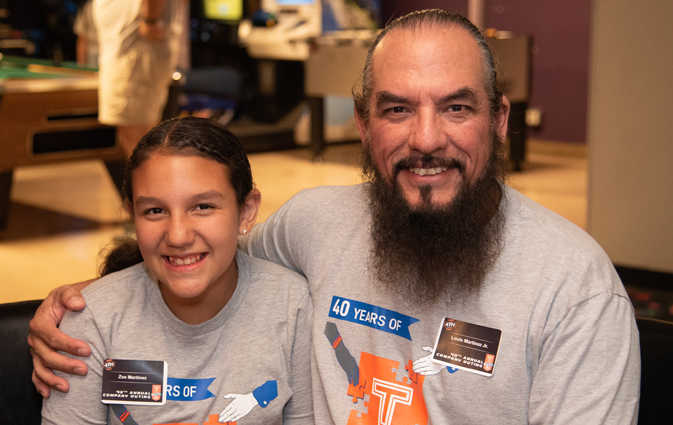
Design Professional Lou Martinez and his daughter.
With his four decades in healthcare planning and design, a list of very impressive projects, and highly satisfied clients, we’re thrilled to welcome Bill to our Fresno office.
Bill’s work ranges from small projects to multi-million dollar ones, and his skills cover all the bases from planning and programming through design and construction, but his added value to healthcare clients rests in his deep knowledge of their industry and his ability to be a trusted adviser to them on all aspects of their growth.
We look forward to building a better (and healthier) Valley with Bill as an integral part of our healthcare practice.
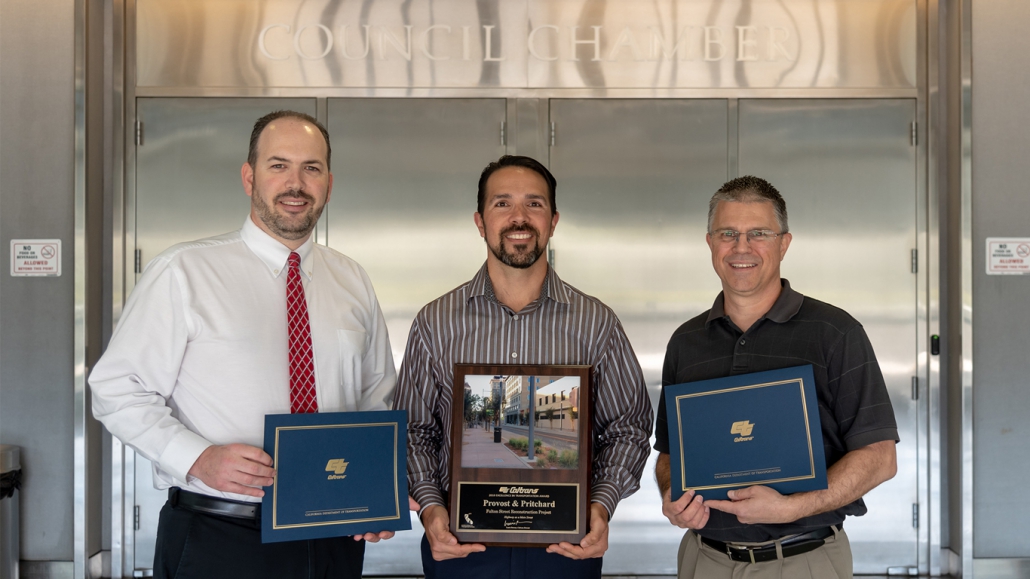
(L-R) Bryan Glass (TETER Partner), Michael Osborn (Provost and Pritchard), and John Rowland (Peters Engineering Group)
Bryan Glass, Electrical Engineer of Record, joins Provost and Pritchard, Peters Engineering Group, American Paving Co., and the rest of the project team as they receive Caltrans’ 2018 Excellence in Transportation Award in the “Highway as Main Street” category for the Fulton Street Reconstruction Project.
“We are excited to be part of the team on this important project for the City of Fresno and to play a part in Building a Better Valley.”
Bryan Glass, PE
TETER Partner and Electrical Engineer
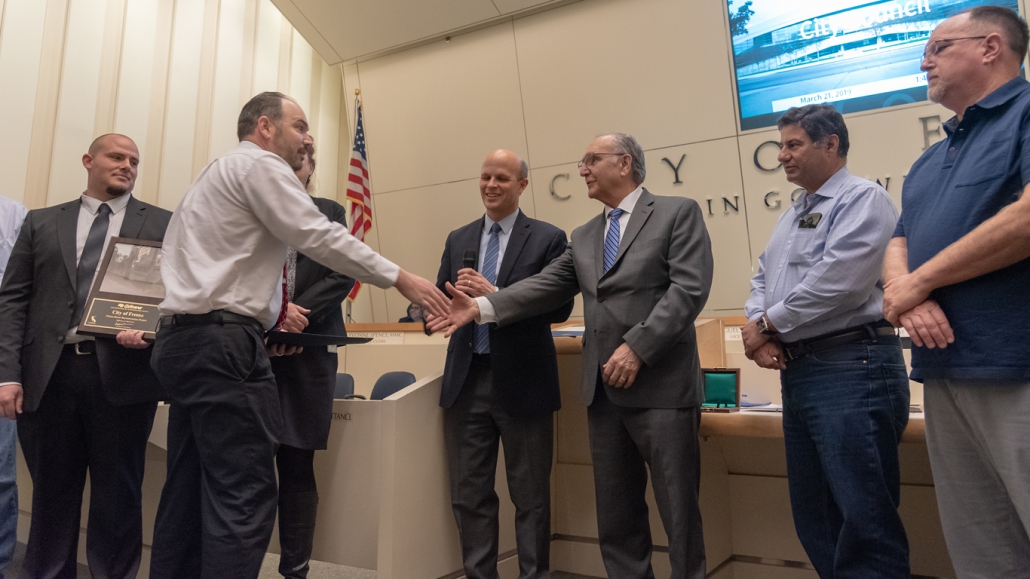
City of Fresno Mayor Lee Brand congratulates Bryan Glass, PE
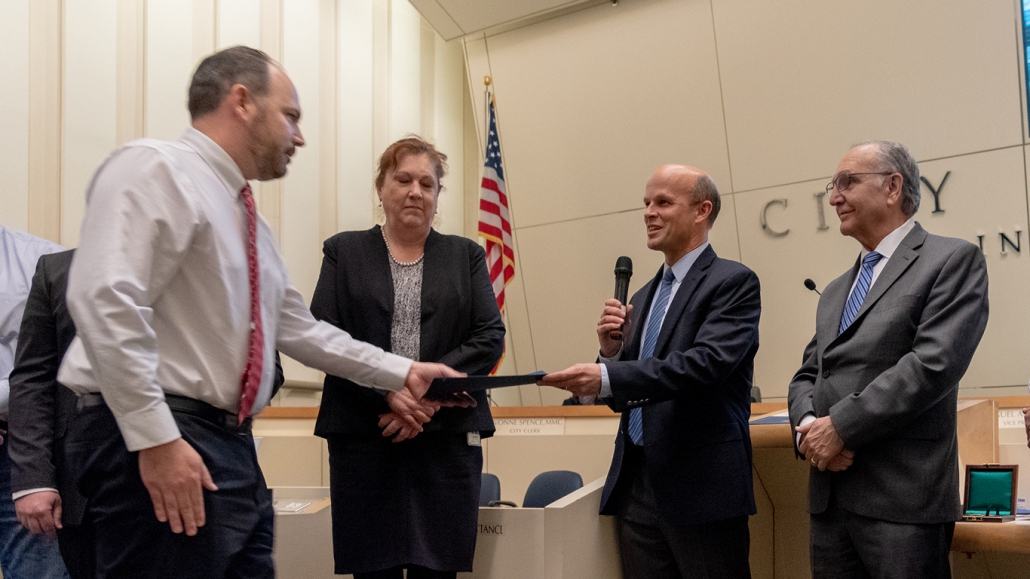
Bryan Glass receives Caltrans’ 2018 Excellence in Transportation Award from Scott Mozier, City of Fresno Public Works Director
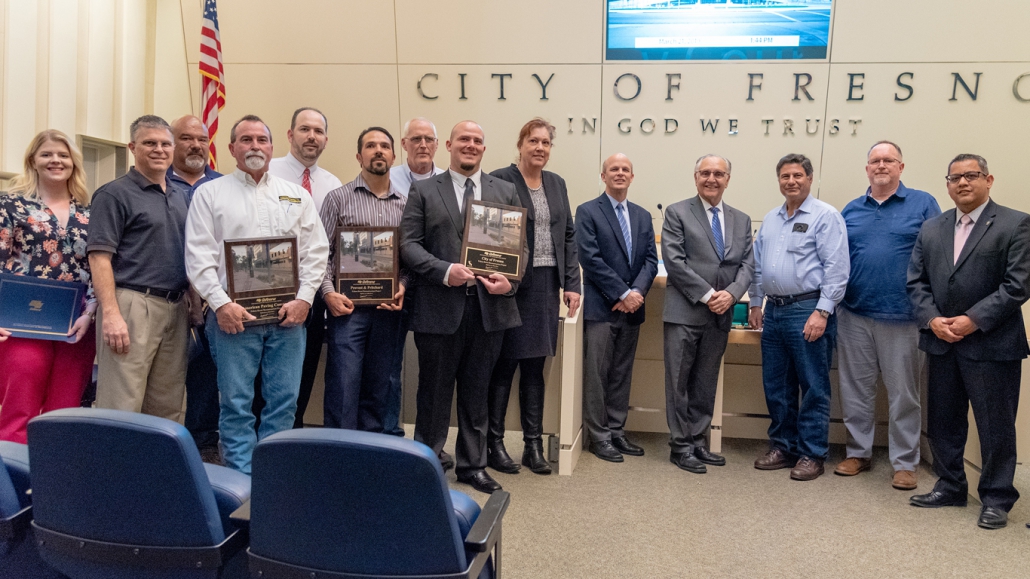
The Fulton Reconstruction Project Team, Caltrans, and City of Fresno
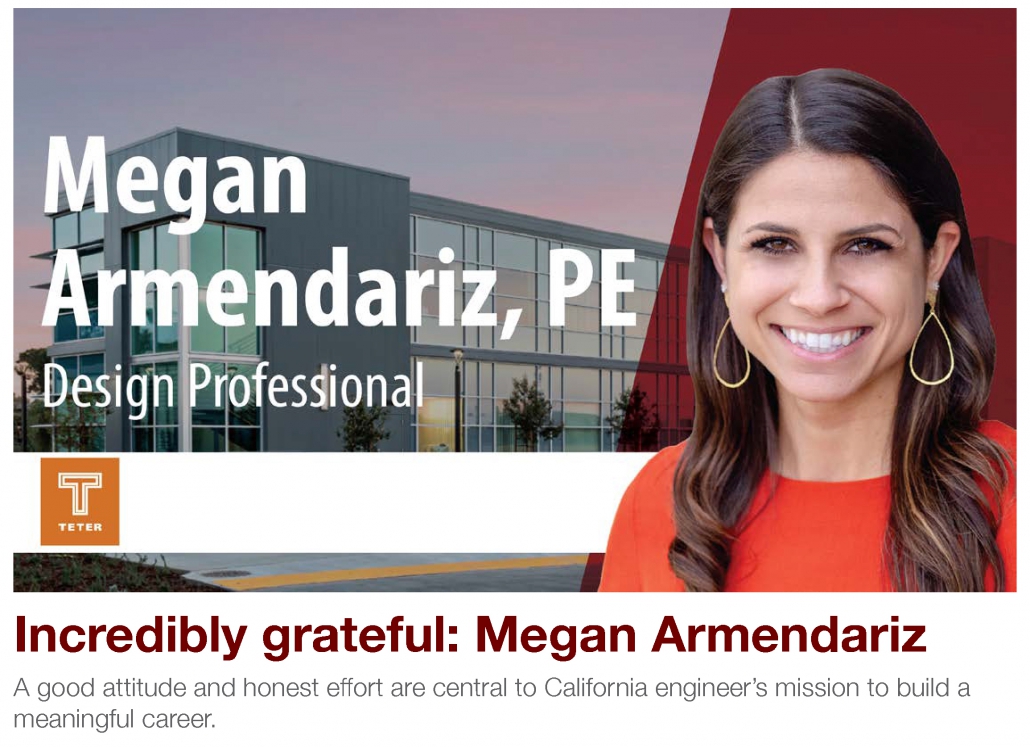
Published by The Zweig Letter on March 18, 2019, Issue 1288
Written by Richard Massey, Editor
Megan Armendariz is an engineer from Clovis, California. A member of the team at TETER since 2014, the 29-year-old has a master’s in structural engineering from Stanford University. She married her prom date from high school, John Armendariz, who, like her, studied civil engineering at Fresno State. Her favorite movie is Remember the Titans, the last book she read is Everybody, Always by Bob Goff, and if she’s listening to the radio and hears an old Beach Boys song – or even something by a ‘90s boy band – that’s a good thing because it brings back fond childhood memories. If you ask her, she’ll tell you: Her parents gave her the self-belief she needed to be successful. A soccer enthusiast who once considered going to school to become a veterinarian, Armendariz is one of those people who gives back to society.
“Ultimately, I want to make the world, or at least someone’s world, better in whatever time I’m given,” she says. “I want to serve, love, and encourage as many people (or adorable animals) as I can.”
A CONVERSATION WITH MEGAN ARMENDARIZ
The Zweig Letter: What’s the best advice you can give to an architect or engineer at the beginning of their career?
Megan Armendariz: Understand the “why” behind what you are doing. Ask questions to understand the purpose of whatever task you’re given and how it impacts the overall project. Whether you’re picking up red marks, or going out to a job site to observe how designs translate in the field, ask questions from the experts around you to better understand the reasoning behind the decisions that were made, so you will then be able to apply the best solution when you find yourself in a similar situation on a different project. However, more important than developing your technical knowledge, understand the “why” as it relates to why you do what you do every day. At the end of the day, what truly motivates you? Understanding this “why” will give you an intention and deeper purpose, and will motivate you to do the very best you can every day.
TZL: Back in 2011, when you first entered the AEC industry, what was your biggest challenge and how did you overcome it?
MA: Like many interns, I had to learn how to relate to real-world challenges. In our profession, no two projects are identical, so I had to learn how to apply those foundational concepts and problem-solving skills to each individual situation, and to convey those solutions in a set of documents that could actually be used in construction. The satisfaction of solving these problems was similar to college; only this time, instead of a letter grade, the reward was a building; better than an individual accomplishment, it was a positive impact on a community.
TZL: On the other hand, what was easier than you thought it would be?
MA: The transition from classmates to co-workers was easier than expected. In college, we worked together to make it through one of the most rigorous majors we could have chosen. Entering the industry, I was pleased to find the same collaborative mentality, with everyone coming together to solve exceedingly difficult problems, and come up with the best solutions possible. I wasn’t treated as an intern or rookie, but rather as a valued member of the team. My peers and leaders respected my perspective and supported me in the transition to the industry.
TZL: What do today’s CEOs and firm leaders need to know about the younger generation?
MA: In my experience with my peers, I think our generation wants to be a part of something bigger than ourselves. We want to ensure that what we do every day, including our careers, has a positive effect on our world. Through our projects, we want to create solutions that are meaningful, conscious of their environmental impact, and will make communities better for the current and future generations. Beyond our professional work, I think many of us also like to be hands-on in making an impact, and gravitate toward a company that shares this desire.
TZL: What is the biggest mistake you’ve made and what was the lesson learned?
MA: In general, one of my biggest mistakes has been a lack of confidence. I’ve always had nothing but the greatest support system my entire life. Yet, when I jumped into my career, or even my first quarter in graduate school, I was intimidated. You feel as though you are surrounded by geniuses who know everything and it can be hard to think that you can ever reach their level of expertise and understanding. The learning curve is so steep when we enter our careers and we know we don’t have all the answers. However, recognizing that lack of confidence was only going to hinder my potential and keep me from reaching all that I could become has made me work even harder to improve. I’ve found solace in recognizing that this industry is ever-changing, that we will always be learning, and that I’m also surrounded by selfless experts eager to share their knowledge and mentor me along this journey.
TZL: There’s an increasing interest in the business side of the AEC business. Do you think the college curriculum could use a few non-technical courses? If so, what are your recommendations?
MA: I think it is very important for everyone to understand the basics of business and how a firm operates as a whole. The more the individuals in a firm understand how we each play a role in the overall success of a business, the more capable we are in helping the firm run effectively. At my first internship, I was fortunate enough to gain some experience in the financial aspects of the company, assisting with payroll, billings, and taxes, among other office management duties. This exposure stoked my interested in business and led me to enroll in an accounting course during graduate school, which introduced me to assets, liabilities, and the many other considerations of operating a business. In my current position, these principles have helped me manage projects and understand the associated financials. I certainly don’t claim to be a business expert (far from it), but I hope to continue my growth in this area, as I realize how crucial it is to the financial health of individual projects and the company as a whole. In addition to business courses, other valuable courses would introduce students to soft skills, like communication, leadership, and project-solving skills. The AEC industry, like many others, is based on much more than technical abilities. The more you can supplement your technical knowledge with business savvy and soft skills, the better.
TZL: You received TETER’s 2018 Be Inspirational award for your work ethic and ability to finish a project. Describe being honored by your peers and how the celebration fits into the company’s culture.
MA: First, I was extremely humbled, and also a bit shocked to receive this award, as I am surrounded by peers who inspire me on a daily basis. “Teople” are the heart of TETER, and we all strive to be EPIC (exceptional, professional, inspirational, and connected to each other, our community, and our clients). These core values drive the work we do. Everyone from our youngest interns fresh out of college and eager to contribute, to the servant leaders among our partners, associates, and veteran staff, exhibit these values, and I am grateful to be among colleagues who are as compassionate and selfless as they are hard-working and dedicated. That’s what makes this peer-voted award so meaningful and special to me, as it comes from those who daily demonstrate what it means to “Be EPIC.”
TZL: Volunteering at an animal shelter. Mentoring high school students. Youth soccer and summer camp. What drives the philanthropic side of your life?
MA: I know I wouldn’t be in the position I am today without the mentorship and encouragement I received from my parents, friends, co-workers, professors, and coaches who took the time to help me grow, and who continue to help me today. I am incredibly grateful for those who have invested in me, and I want to do all I can to pass that along. Plus, many of the activities simply bring great joy to my life. Soccer is and always has been one of my greatest passions, and I treasure any chance I get to share the love of the game with the next generation. I get to watch them build that camaraderie, learn the life lessons that come with playing sports, and develop relationships that may last a lifetime. Mentoring high school students is also very rewarding, as I’ve always enjoyed school and learning, and now get to contribute to helping these students grow their passion. Ultimately, I want to make the world, or at least someone’s world, better in whatever time I’m given. I want to serve, love, and encourage as many people (or adorable animals) as I can.
TZL: TETER has crossed the 100-employee threshold and recently opened new offices in Modesto and San Luis Obispo. How has growth affected you specifically and the firm in general?
MA: Growth presents more opportunities for staff, including myself, to stretch ourselves and take on new roles. It also allows for more in-house development opportunities, like mentorship and training, which betters both our employees and our firm.
TZL: It seems like you have developed a specialty working on projects for public clients. What are the pros and cons of doing design work for public owners?
MA: My favorite part of working on public projects is the opportunity to serve the educators, students, and communities who will benefit from the work we do. Some of my childhood friends now work at the schools we’ve designed, or have children who attend them. In my experience, the public owners, whether school superintendents or government officials, have the same passion for serving their communities and providing them with the best facilities possible. They have great pride in their projects, and being able to help them make their dreams become reality is extremely rewarding.
TZL: What drove your decision to become an engineer in the first place? Was there ever a different career you wanted to pursue?
MA: Being an animal lover since I was a child, my heart was set on becoming a veterinarian, until I realized I’d have to face the reality of not being able to save every animal. Although soccer was a huge part of my youth, I think the practical side of me recognized that I was probably not going to have a lifelong career on the pitch. I loved art, but was also partial to the challenges presented in my math and science courses. Architecture seemed to be a perfect balance of my regard for both the left and right brain activities. However, I also had a mentor from an early age who is still the most passionate structural engineer I’ve ever met. He guided me through science fair projects about coefficients of friction and the thermal properties of wood, took me along on job sites, and most importantly, believed that I could become an engineer in a male-dominated field. His passion, along with my parents’ constant encouragement and support of whatever I chose to do in life, helped lead me to engineering.
TZL: What’s the most important thing you’ve ever learned from a mentor?
MA: While I have many great mentors in the industry who help me with everything from technical knowledge to work-place confidence, my greatest mentors have been my parents. They’ve taught me to believe in myself like they do, and have led by example in their own careers and in their roles as parents and life mentors. At a young age, I learned from them that there were two things I could always control – my attitude and my effort. This advice guides me in my profession and in all other aspects of my life.